Ever wondered about the history of art in Norway, if Munch is the only famous Norwegian artist, or where the best places to see art in Norway are? Read on to find out!
Norway is often considered to be the home of the Vikings – but it is also home to a spectacular collection of beautiful art just waiting to be experienced!
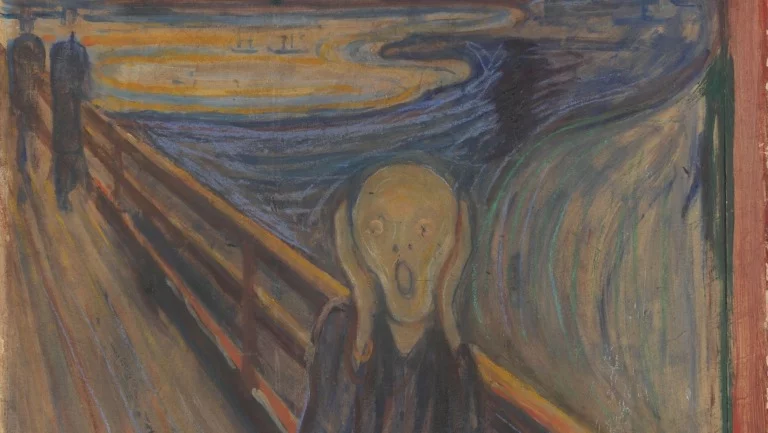
The word “art” can be used to describe lots of different things and activities, from music to literature, theatre to architecture, opera to interpretive dance, etc. This article is going to focus on art in the form of paintings, sculptures, carvings, crafts, etc.
Whether you’re a proud aesthete or someone who just doesn’t feel their trip to Norway would be complete without seeing The Scream in person, we have everything you need to know about Norwegian art!
Table of Contents
Prehistoric Norwegian art
The oldest art in Norway comes from the stone age. Prehistoric art takes the form of petroglyphs (rock carvings) or pictographs (rock paintings) that depict activities of the time, such as hunting and fishing, as well as people and animals native to the area.
However, historians remain unsure about what the purpose of this art was.
The Northern Norwegian municipality of Alta is home to the largest collection of prehistoric art in both Norway and Northern Europe.
The Alta Rock Art consists of numerous petroglyphs and pictographs spread out across five main sites: Hjemmeluft, Kåfjord, Amtmannsnes, Storsternen and Transfarelv.
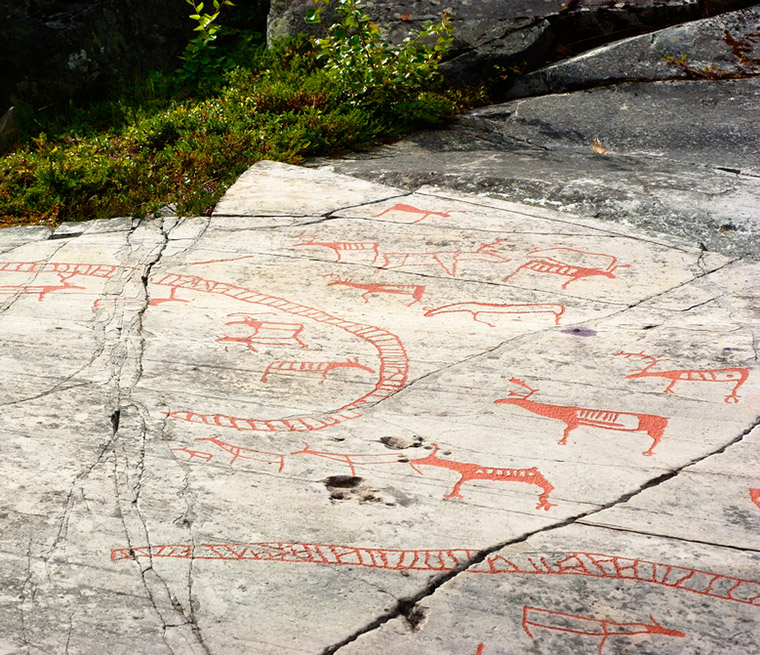
The Hjemmeluft petroglyphs can be visited as part of the Alta Museum. Unfortunately, the other sites are not open to the public, though they can be viewed online.
The Alta Rock Art is currently one of eight UNESCO World Heritage Sites in Norway, and the only prehistoric one. However, it is not the only place where you can find prehistoric art in Norway.
While the majority of these are also inaccessible, some sites welcome visitors, including Bøla in Steinkjer (home to the famous Bøla reindeer), Ekeberg in Oslo and Solbakk in Rogaland.
Viking art
You might think that the only artistic activities the Vikings engaged in was occasionally grabbing their swords and “painting the town red” – but they also created art in the literal sense.
While art today tends to be created purely to be admired, Viking art seemed to have been used to decorate functional objects. For example, doors were embellished with carvings, ship posts were whittled into the shape of animal heads, and even earspoons were embellished.
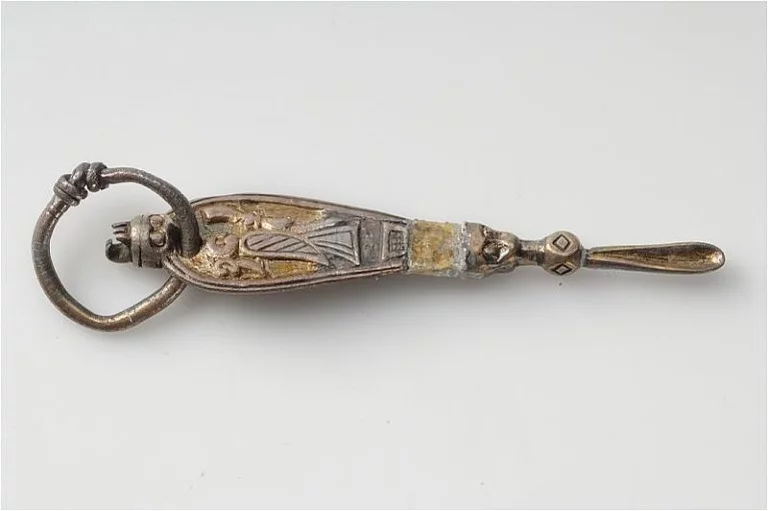
Therefore the best place to see Viking art is in museums that hold Viking artefacts. Luckily, we have a list of the best Viking museums in Norway with plenty of places for you to check out!
That said, the majority of Viking art we have today was made from materials that have survived the passage of time, such as stone, metal, wood, bone, etc.
There is some written evidence that Vikings created art for purely aesthetic purposes, such as tattoos and tapestries. However, since cloth, skin and paper biodegrade quickly, we are unlikely to find any examples of this type of Viking art today.
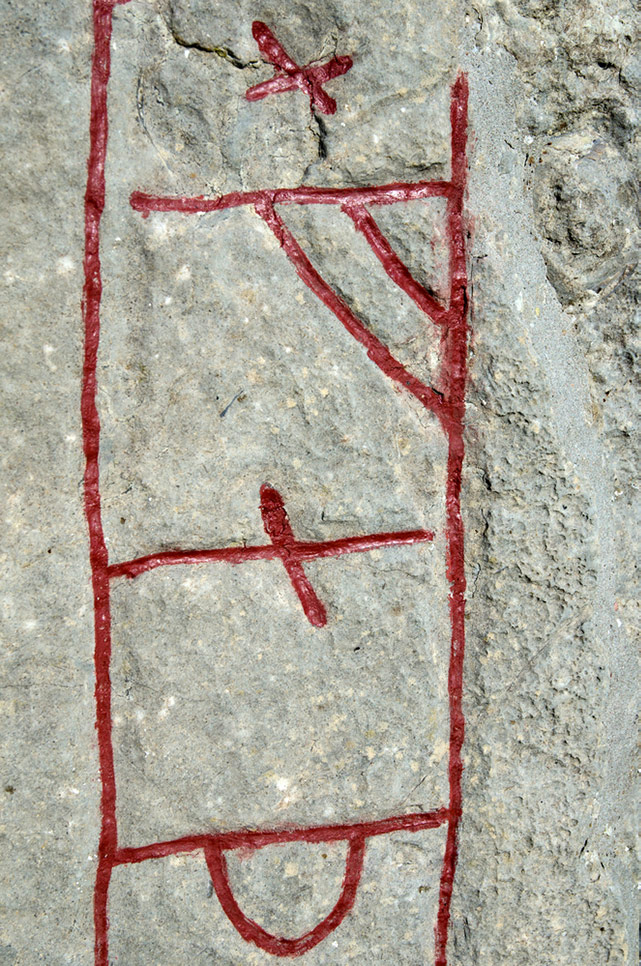
Viking art tends to be categorised into six distinct styles, which are each named after the geographical location where the objects in this style were found:
Oseberg (approx. 9th century), named after artefacts found in Oseberg, Norway (including the Oseberg ship)
Borre (approx. 9th – 10th century), named after artefacts from the Borre Mound Cemetery, Norway
Jellinge (approx. 10th century), named after artefacts found in Jellinge, Denmark
Mammen (approx. 10th – 11th century), named after artefacts from a burial mound in Mammen, Denmark
Ringerike (approx. 10th – 11th century), named after a type of stone used for carvings from Ringerike, Norway
Urnes (approx. 11th century – 12th century), named after a stave church in Urnes.
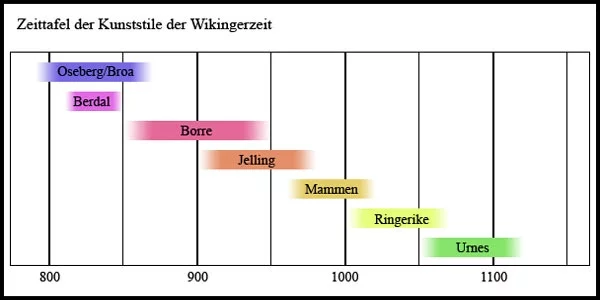
It is important to remember that these styles were created retroactively by historians to group art styles by certain characteristics. The boundaries between them are not always clear cut.
Norwegian folk art
Although folk art is not a new concept, it was not recognised as “art” until the late nineteenth century.
Traditionally, folk art refers to functional items that were decorated with certain motifs or using particular techniques. The people who created them had no formal training as artists or craftsmen; instead, the skills were handed down through generations.
One of the most recognisable types of Norwegian folk art is “rosemaling” (or “rose painting”), named after the floral designs that characterise the artwork. While rosemaling can be found all over Norway, it has its strongest roots in rural Eastern Norway, particularly in Hallingdal and Telemark.
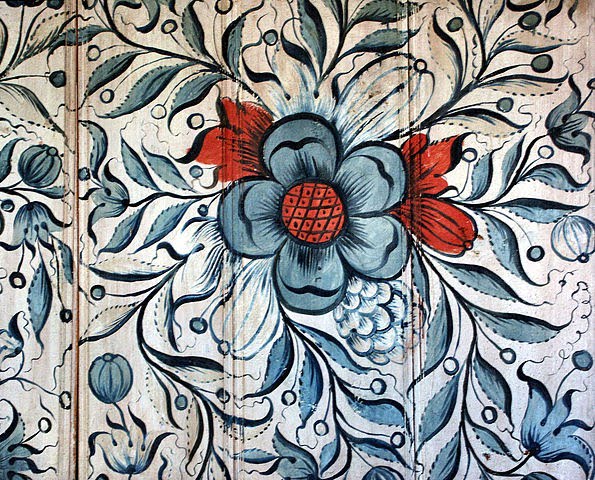
Rosemaling is a relatively young form of folk art, developing in the eighteenth and nineteenth centuries. It was influenced by other popular European art styles of the time, including Baroque, Regency and Rococo, which is evident in the paintings’ colours and use of “S” and “C” curves.
While rosemaling has general characteristics, each region developed their own style of painting, which often enables the artwork to be connected to a specific place, if you know what to look for.
In the eighteenth century, artists tended to be trained professionals from the cities. They would travel around Norway, providing their services where needed.
People in rural areas would then try and copy this art, but did not have the training – nor the restrictions that came with it. Therefore, they were able to be much more creative with their designs, which allowed rosemaling to evolve into its own distinct style.
Originally, rosemaling was used to decorate items but, much like the vines and flowers they depict, the designs soon spread around the room to cover ceilings, doors, and walls.
Rosemaling went out of fashion in Norway in the late 19th century. However, it has since become increasingly popular among Americans with Scandinavian ancestry.
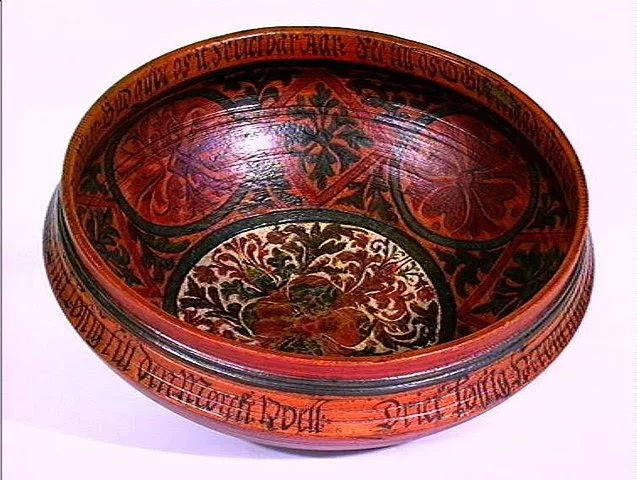
If you want to see original rosemaling for yourself in Norway, you should pay a visit to the Norwegian Museum of Cultural History in Oslo, which holds many buildings and objects decorated in this way.
Sámi art in Norway
The Sámi are the indigenous people to Norway, Sweden, Finland and Russia, with their own culture and language – and their own art.
Traditional Sámi art combines functional objects, such as knives, cups, shoes and bags, with beautiful designs. In North Sámi, this type of handcraft is known as “duodji”.
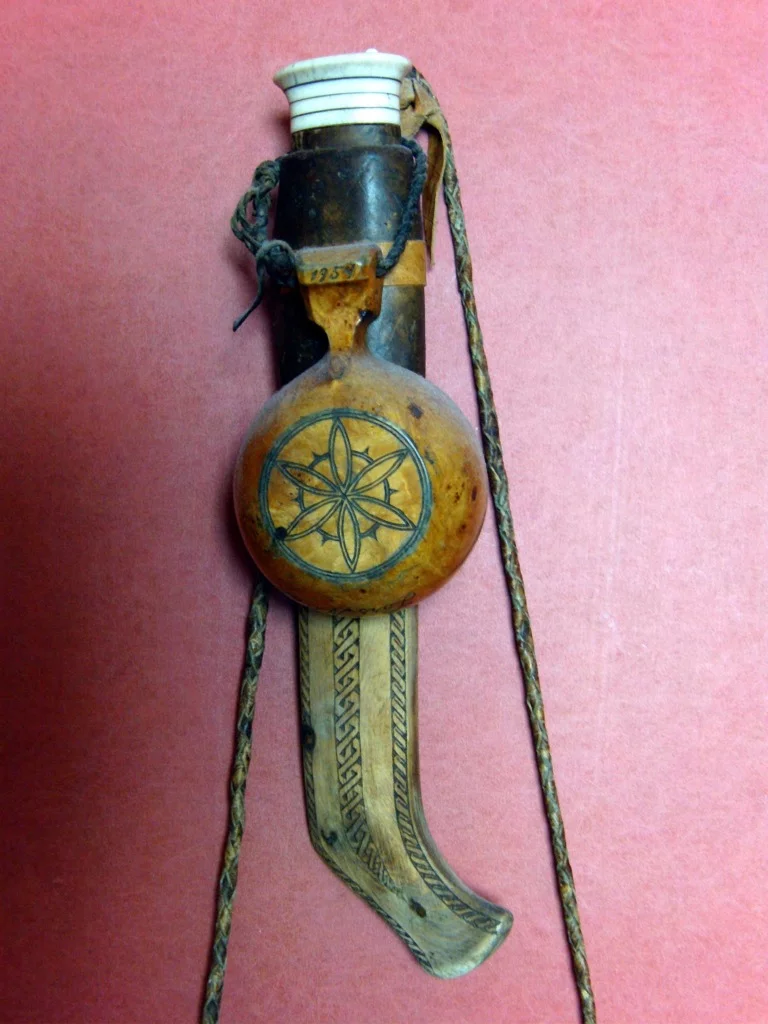
The Sámi Dáiddamagasiidna (the Sámi Art Collection) holds a large collection of duodji and Sámi-produced art. While this collection is closed to the public, it lends its pieces to both the Sámi Parliament building and Sámiid Vuorká-Dávvirat (the Sámi Museum in Karasjok), which are open for visitors. The Várjjat Sámi Musea (the Varanger Saami Museum) also has a large collection of duodji on display.
Famous Norwegian artists
Although the people who live in Norway have clearly been creating art for a long time, Norwegian artists weren’t particularly well known until the Romantic period.
Romanticism was a European cultural movement that lasted from the end of the 18th century to the mid 19th century, and impacted areas such as art, music and literature. It was driven by patriotism in the form of an idealised nostalgia for a “simpler time” and a focus on landscapes and nature – which can be particularly seen in art from the time.
Johan Christian Dahl (1788-1857)
Johan Christian Dahl was an artist who specialised in oil paintings of Scandinavian and German landscapes. Not only is he credited with kick-starting Norwegian romanticism, which peaked between 1840 and 1870, but he was also the first Norwegian painter to gain recognition abroad.
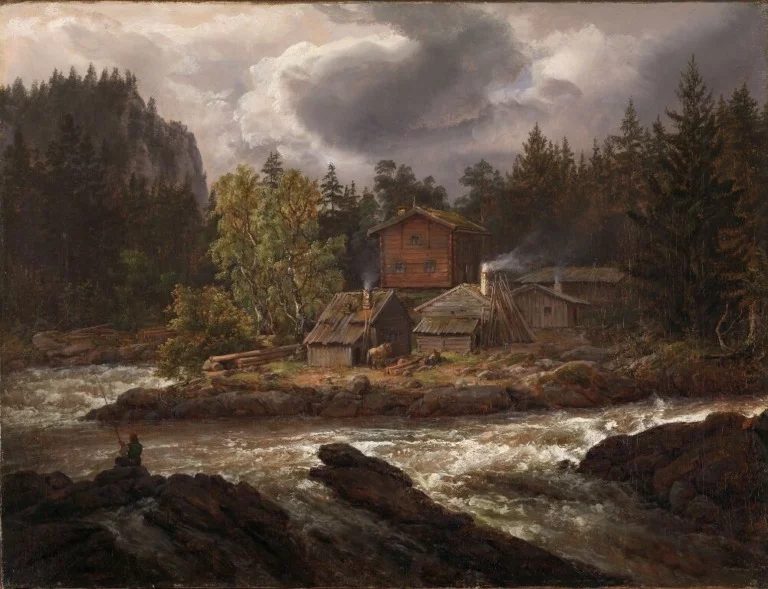
In addition to creating artwork, Dahl also played a significant role in the preservation of existing artwork. He supported the National Museum of Art, Architecture and Design (now part of the new National Museum), helped establish the Fortidsminneforening (Society for the Preservation of Ancient Norwegian Monuments), and pushed for the restoration of old buildings, including Nidaros Cathedral in Trondheim.
Erik Werenskiold (1855-1938) and Theodor Kittelsen (1857-1917)
Erik Werenskiold and Theodor Kittelsen are the fairytale artists of Norway. Together, they illustrated numerous fairy tales from Asbjørnsen and Moe, giving faces to key characters in Norwegian folklore.
Read more: A Fairy-Tale Traveller’s Guide to Norway
For Werenskiold, illustrating fairy tales seems to have been the exception in his artistic style. He was part of the naturalist (or realist) movement, and the majority of his art depicts the everyday life of ordinary people, often outdoors.
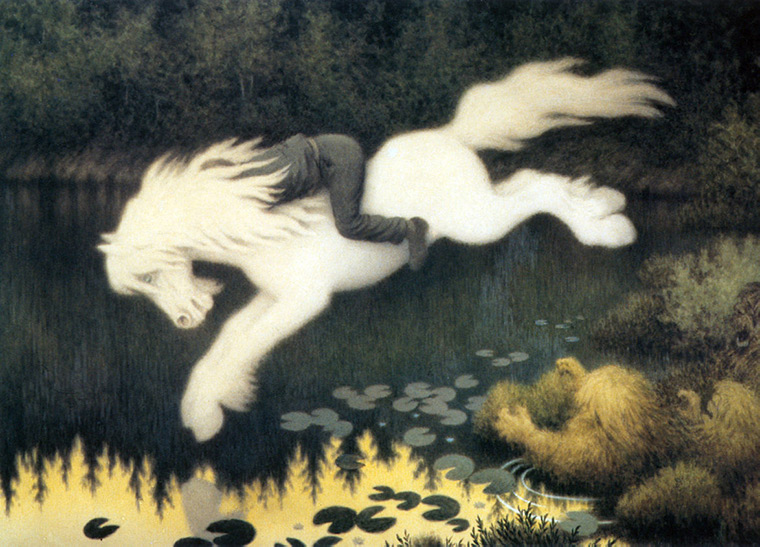
Kittelsen’s art also liked to focus on the outdoors and landscapes; however, he “fortrollet naturen” (made the natural unnatural) by incorporating fantastical elements into them, such as the Nøkk at Tårntjernet lake.
Christian Krohg (1852-1925) and Oda Krohg (1860-1935)
Christian and Oda Krohg were a married couple as well as famous painters in their own rights.
They were both members of “Kristiania-bohemene” (the Kristiana Bohemians), which was a group of Oslo-based academics, students, artists and writers. Edvard Munch was closely associated with this group for a time, and Christian Krohg acted as his mentor.
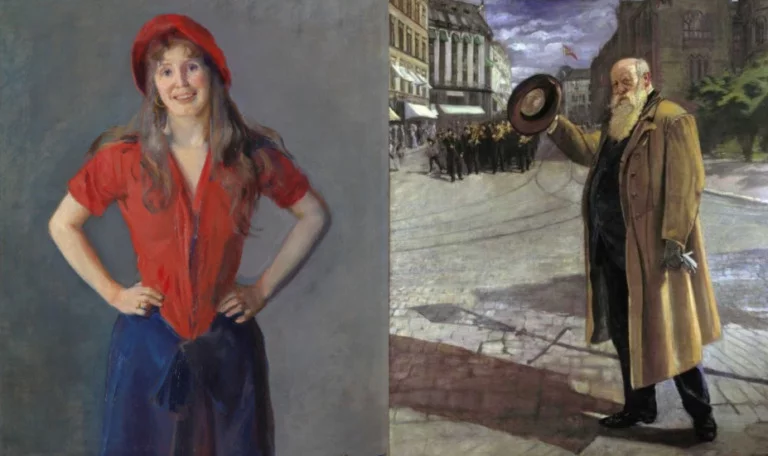
Naturalism was a significant influence on Christian Krohg’s art, and the majority of his paintings are detailed depictions of people performing everyday tasks. Oda Krohg studied art under both Erik Werenskiold and Christian Krohg before marrying the latter.
However, her work is considered to have helped establish the neo-romantic style in Norwegian art, particularly with “A Japanese Lantern”.
Edvard Munch (1863-1944)
Undoubtedly, the most famous Norwegian artist is Edvard Munch. Despite his success as an artist both in Norway and abroad, his life was characterised by unhappiness as he struggled with both his mental and physical health.
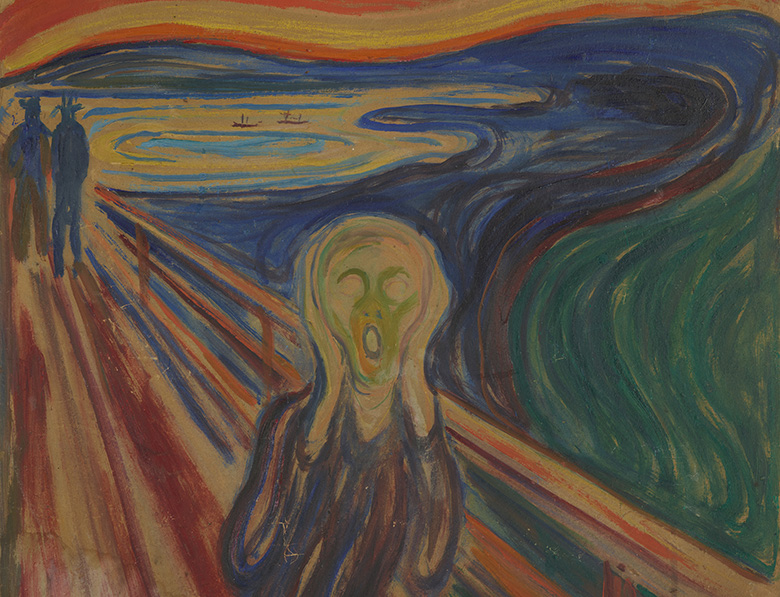
However, the period in which he struggled the most is also when he produced his most famous artwork, including “The Scream” (originally called Der Schrei der Natur – The Scream of Nature).
Munch actually painted four different versions of “The Scream”. The best known one, and the one that's part of Norway’s new National Museum collection, is the oil painting version from 1893.
Nikolai Astrup (1880-1928)
Not to be confused with the politician of the same name, Nikolai Astrup was a Norwegian artist known for his use of vivid colours in his landscape depictions. His style has been compared to Munch’s – but happier.
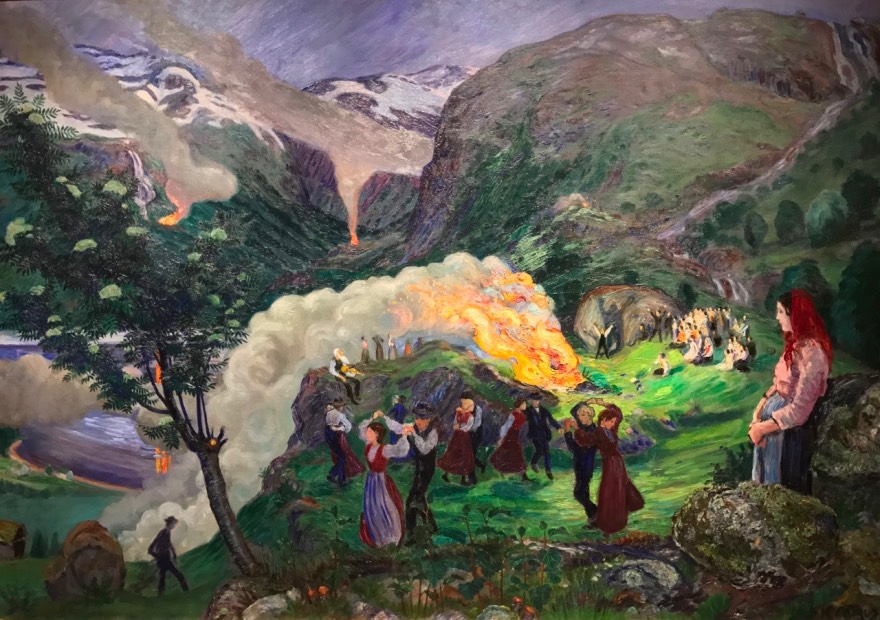
Although he travelled all over Europe, he never lost his love of western Norway, where he had grown up. He later returned to settle down in the old Jølster municipality (now part of the Sunnfjord municipality), and the majority of his paintings were inspired by the mountains and valleys of this area.
While Astrup’s work is famous in Norway, he has only recently achieved international recognition.
Best Norwegian art museums
Now that you know about some of Norway’s most famous artists, you need to know where you can see their (and other) famous artworks in person. There is a wide variety of art museums all over Norway, but here is a selection of our favourites:
The National Museum of Art, Architecture and Design, Oslo
The National Museum houses the largest collection of art in the Nordic countries, from contemporary pieces to well established classics, such as The Scream (though make sure you stand at a reasonable distance).
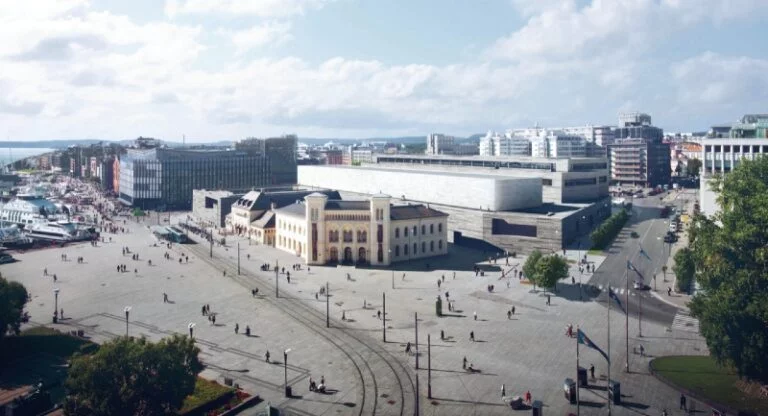
While the museum is relatively new, it consists of some of the oldest art institutions in Norway, such as “Nasjonalgalleriet” (the National Gallery of Norway).
The Munch Museum, Oslo
While some of Munch’s work can be seen in other museums, the majority of his work is housed at the new Munch Museum, which opened in Oslo in October 2021.
If you’re a Munch enthusiast, or just happen to be in the area, you should pay a visit to Edvard Munch’s summer house in Åsgårdstrand, where he painted numerous famous works. There is also a virtual tour of the house available on the Munch Museum’s website.
Astrup Fearnley Museum, Oslo
The Astrup Fearnley Museum is a private art collection that opened to the public in 1993 and moved to the shores of the Oslofjord at Tjuvholmen in 2012. It also frequently hosts contemporary art exhibitions from both Norwegian and international artists alike.
The KODE Art Museums and Composer Homes, Bergen
KODE consists of seven buildings, of which four are dedicated to art and three are dedicated to the composers Edvard Grieg, Ole Bull and Harald Sæverud, respectively.
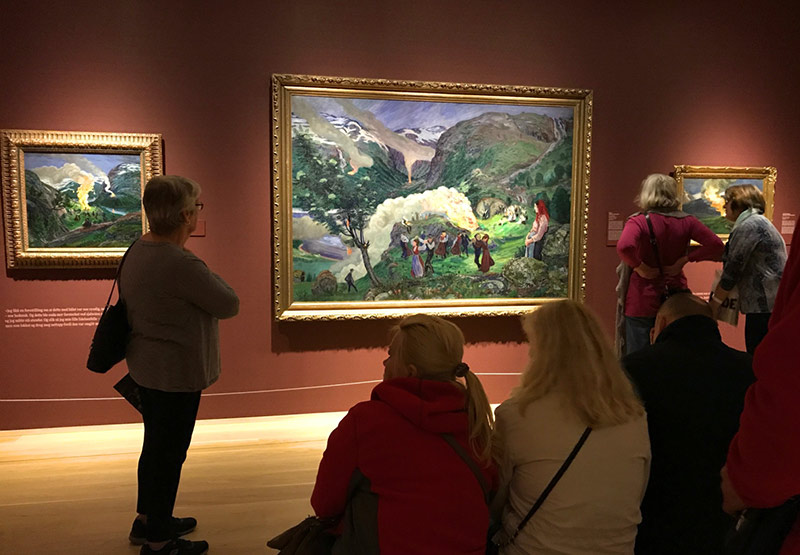
The four art museum buildings are numbered KODE 1-4 and each have a different focus, from the Golden Age of Norwegian art to the largest collection of Chinese china figurines in Norway.
Stavanger Art Museum, Stavanger
The Stavanger Art Museum is housed in a giant glass dome: a piece of artwork to be admired in itself. It houses over 2600 pieces of artwork dating from the time of its establishment in the 1800s to more modern pieces.
While it focuses on Norwegian artwork, it also hosts exhibitions from artists all over the world.
The Art Nouveau Centre and the KUBE Art Museum, Ålesund
Jugentilsenteret (the Art Nouveau Centre) is a museum that focuses on the “art nouveau” style, which is the architectural style that the town was rebuilt in after it was destroyed by a fire in 1904.
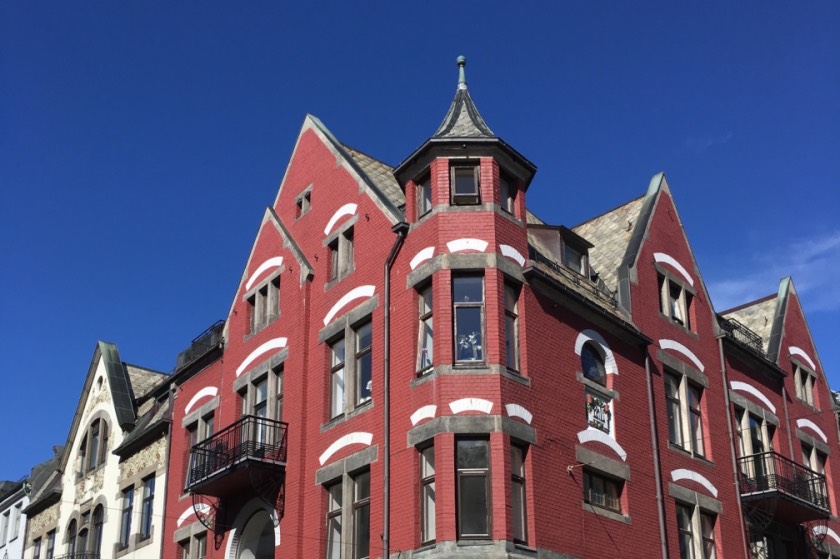
The KUBE Art Museum is next door in a building that used to be an office for Norges Bank (and presumably gets its name from the building’s cuboid shape). It is both an educational and art centre that features artists and artwork from the surrounding region.
The Nordnorsk Kunstmuseum, Tromsø
The Northern Norwegian Art Museum was founded in 1985 as an exhibition and education centre for Northern Norwegian art, and moved into its current building in 2001. It regularly hosts exhibitions that explore issues related to the North, such as “Make the North Great Again.”
You are free to wander around and discover the artwork for yourself, or you can join a free guided tour at 2pm on Sundays. Other guided tours at different times can also be arranged with the museum.
The Sámi Center for Contemporary Art, Karasjok
Sámi Dáiddaguovddáš was founded in 1986 with the intention of educating people on Sámi art, as well as supporting Sámi artists.
The center hosts around ten different exhibitions a year, and is also home to its own collection of Sami artwork, ranging from duodji to more contemporary pieces.
Best Norwegian sculpture parks
Art museums are not the only place you can find art in Norway! The country is also home to a variety of open-air sculpture parks for you to wander around at your leisure.
While there are a number of sculpture parks in Oslo, the most iconic is “Vigelandsparken” (Vigeland park).
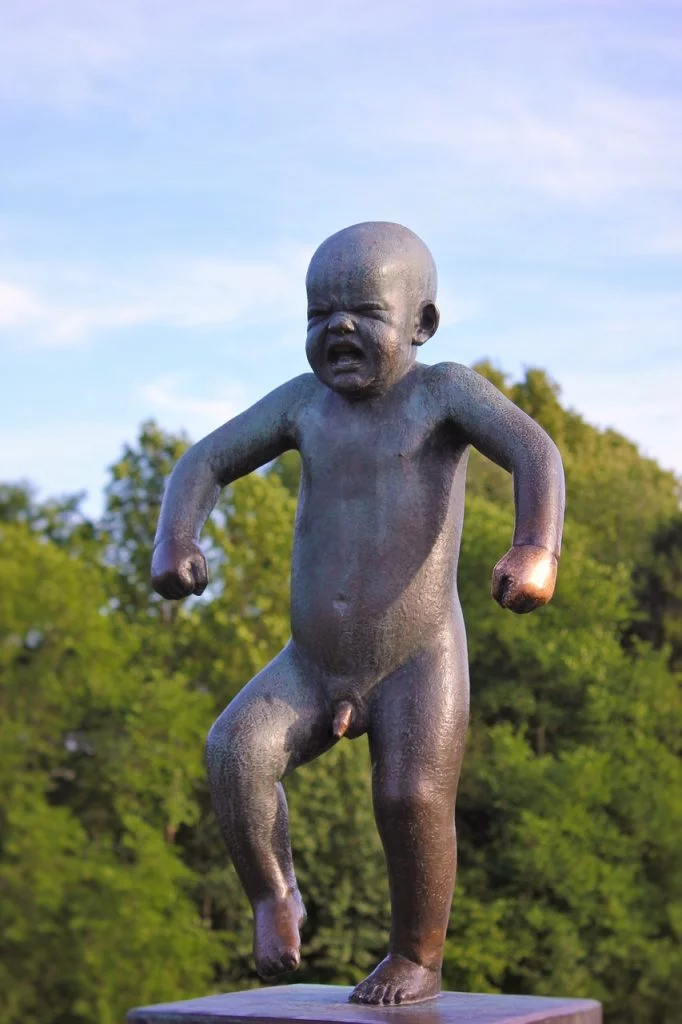
Situated in the middle of Frogner park, the sculpture park consists of over 200 statues, all created by Gustav Vigeland. The most famous sculpture is “Sinnatagen” (The Angry Boy) and touching his hand is said to give you luck – although this is not encouraged due to potential damage to the statue.
Personally, my favourite state is the man fighting off numerous babies.
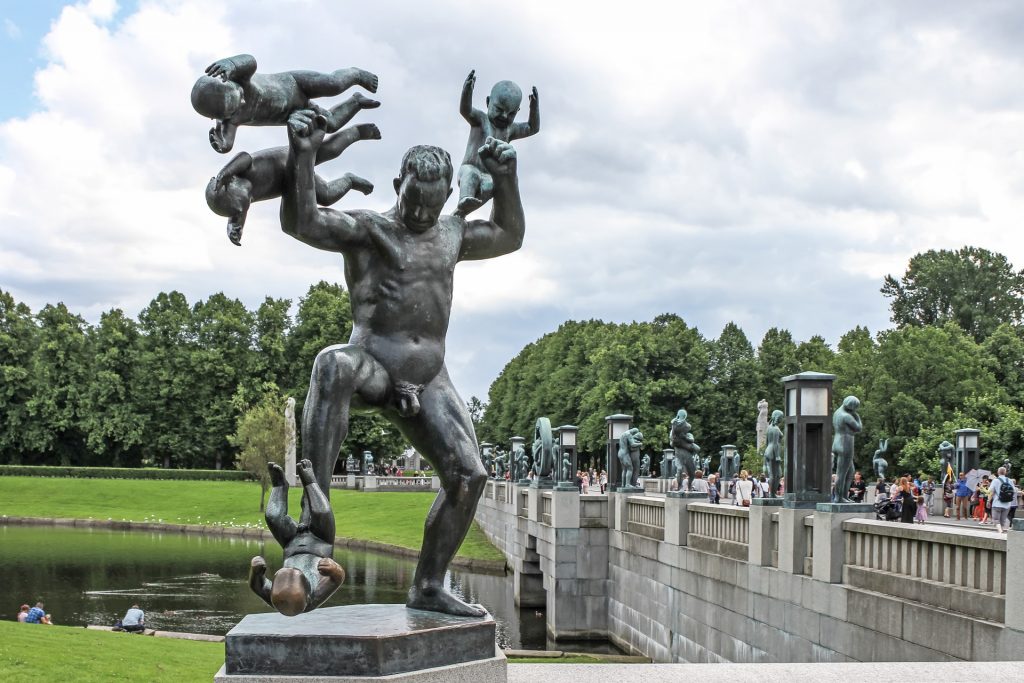
One of the more recent sculptures in Oslo is “Roseslottet” (the Rose Castle), which opened in June 2020. It was built to mark the 75-year anniversary of Norway’s liberation from Nazi Germany and gets its name from The White Rose resistance group.
The art installation consists of a circular wooden path, surrounded by paintings on either side, that spirals into the centre: from a bird’s-eye view, it looks like a rose.
Elsewhere in Norway, the “Sverd i fjell” (Swords in Rock) in Stavanger was built as a monument to the Battle of Hafrsfjord in 972, and consists of three giant swords emerging from the ground as if plunged there by a giant.
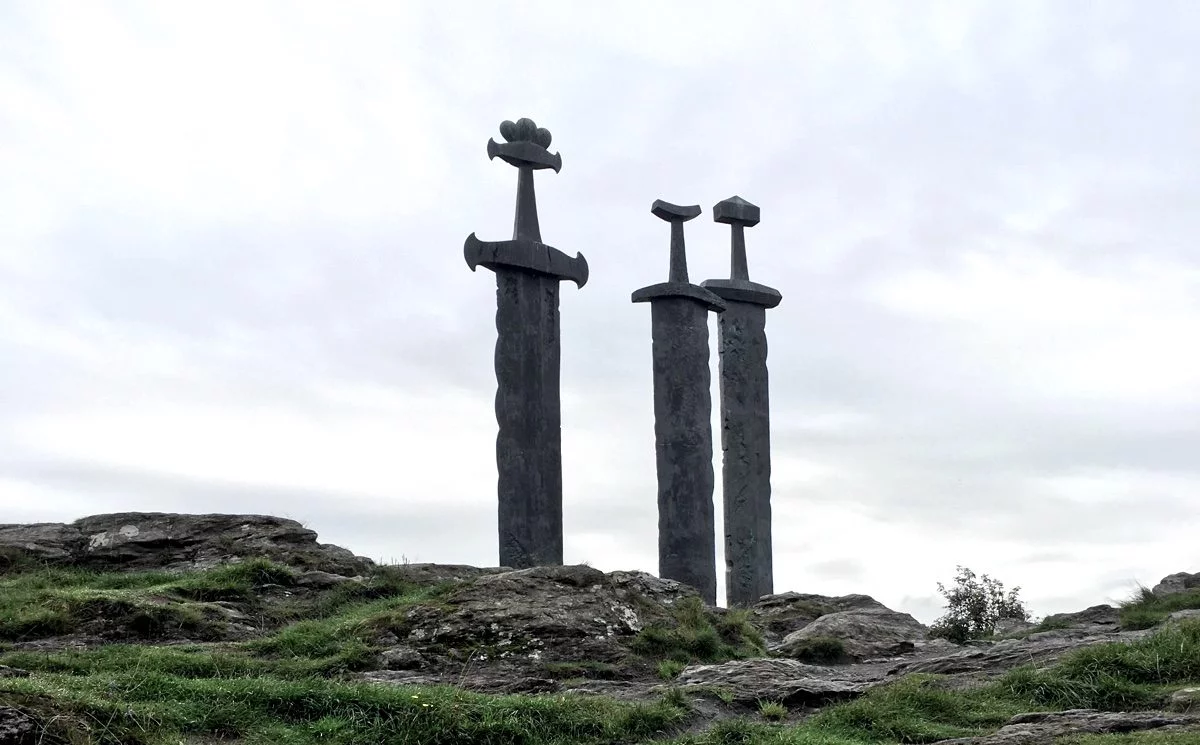
Close to Stavanger is “Eventyrskogen” (The Fairytale Forest), which is a forest full of creatures from Norwegian fairy tales – and is probably the closest you’ll get to encountering a real troll in Norway (a tame one at least).
Norwegian street art
When we say “best Norwegian street art”, we don’t mean someone’s name scrawled onto a wall. We’re talking about massive, colourful murals that take up entire sides of buildings and risqué pictures of the Mona Lisa flashing passersby!
There’s absolutely no reason for art to be confined to indoors – or even to a single canvas! From Bodø to Stavanger to the Swedish border, Norway has some amazing street art just waiting to be uncovered!
Grab yourself a cup of coffee and experience some awe-inspiring art while embracing the Norwegian principles of “friluftsliv!”
Want to study art in Norway?
Are you inspired by Norwegian landscape and history, like so many artists before you? There are plenty of places where you can study art in Norway!
Oslo National Academy of the Arts (KHiO) offers ample opportunity to study any type of art to a bachelor and master level at the Academy of Fine Art, the Art and Craft department or the Design department. The school also consists of an Academy of Dance, Academy of Opera, and Academy of Theatre.
The Faculty of Fine Art, Music and Design (KMD) in Bergen offers both bachelor- and master-level degrees in art, music and design. Their fine arts programme allows students to specialise in areas as photography, painting, textiles, etc.
The Trondheim Academy of Fine Art (KIT) is part of the Faculty of Architecture and Design at NTNU. It offers the opportunity to study visual art at both a bachelor and master level.
The Academy of Arts at the Arctic University of Norway in Tromsø offers bachelor and master-level degrees in fine art, as well as one-year courses. The Academy also has close connections with other art institutions in Tromsø, including the Nordnorsk Kunstmuseum and the Tromsø Kunstforening.
What’s your favourite art in Norway? Do you have any questions about Norwegian art that we did not answer? Let us know in the comments!

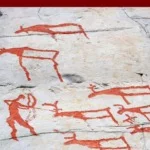

My Grandfather, “Pop” was born in Norway and had a friend who was an artist. H Skouverøe was his name, and the paintings I have are mostly ships on the sea. I would like to know more about him, where could I look? Thank you for the beautiful website❤️
I bought a picture at auction by artist Narkin 1911, and am wondering if you’re familiar with the artist. If you would care to look at it, please email me and I’ll send photos.
Thank You!